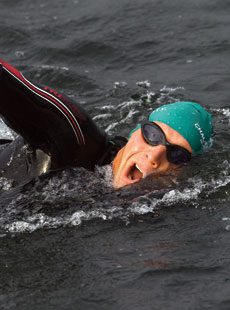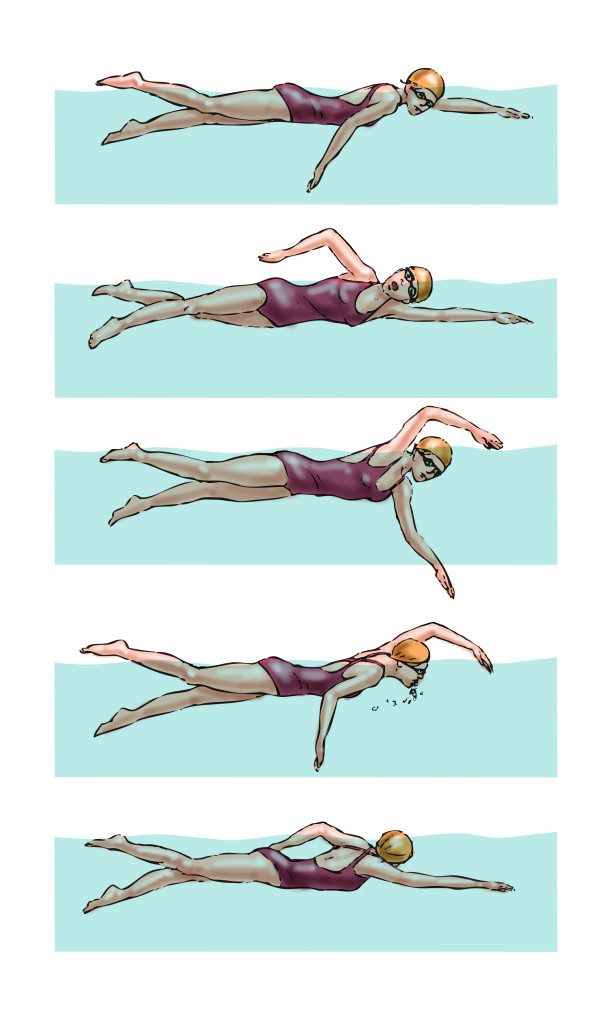Swim training: master your breathing

-By Ayesha Rollinson
Breathing technique is the key to swimming fast, swimming relaxed and your buoyancy. It is the single most important technical skill that swimmers must master, and it is the skill that is most often misunderstood, poorly taught and ignored. Below, I explain how to breathe and improve your breath-holding capabilities.
Here are the steps to proper bilateral freestyle breathing.
1. While your right hand is pushing water past your hips and your left hand is extended out front, turn your head to breathe to the right.
2. Keep your left hand extended and take a full breath as your right arm is recovering.
3. As your right arm sweeps past your right shoulder, turn your head back into the water and start the catch on the left side.
4. Hold your breath for two complete strokes: one on the left, one on the right.
5. When your left hand starts the catch on the third stroke, quickly blow all your air and relax your diaphragm.
6. While your left hand is pushing water past your hips and your right hand is extended out front, turn your head to breathe to the left.
You should practice these steps on land in front of a mirror before trying them in a pool. Swimmers must train their minds and bodies to voluntarily hold their breath under physical duress. In most sports breathing rate is automatically, or involuntarily, adjusted by your brain to match your body’s physical exertion. In an article in the April 2012 issue of American Scientific, Michael J. Parkes argues that voluntary breath holding is controlled by a different mechanism than our regular dayto-day breathing. Using the evidence from decades of scientific studies, Parkes insists that the time limit – signalled by a strong urge to take a breath and commonly referred to as “break point” – is not determined by rising levels of CO2 in our blood. Instead, Parkes concludes that voluntary breath holding is controlled by sensory information sent to the brain from your contracted diaphragm muscle. He argues that the brain considers these distress signals with other environmental factors and makes a decision about how much discomfort is tolerable. The good news for swimmers and triathletes is that you can hold your breath longer than you think. There is no reason why you can’t hold your breath for three, four or more strokes. The evidence would suggest that everyone is capable of the breath control required for flip turns. The bad news is that you have to commit to training your mind and body to execute these skills.
There are several ways you can improve your voluntary breath control. Within your regular swim workout try slowing your arm cadence and using a catchup-type stroke. This will reduce your heart rate to allow you to focus on your diaphragm contraction and relaxation. Do drills that emphasize slow arm recovery and bilateral breathing during your training sessions.
You can strengthen your diaphragm while training your brain to suppress breath-holding distress signals by practicing hypoxic swimming. Hypoxic swimming is simply doing intervals of up to 400 m with a restrictive breathing pattern. An example of a hypoxic breathing pattern would be to breathe once every five, seven or nine strokes. Another variation on this exercise is to limit the number of breaths per length: four breaths per 25 m, for example. Competitive swimmers practice this several times per week. A passive way of training your body for the stress of voluntary breath control is to practice flip turns. A 3,000 m workout is an opportunity to do 100 flip turns. This is 100 opportunities to train your mind and body to be a more relaxed and efficient breath-holder.
Breathing shouldn’t be complex or intimidating. There are six steps to follow and a little bit of neuromuscular training to endure for you to become the master of your breath.
Ayesha Rollinson is a master’s swim coach and runs Team Atomica.

